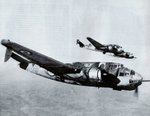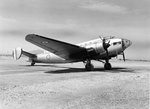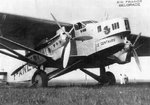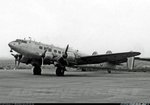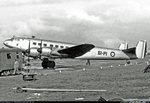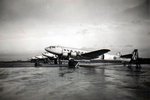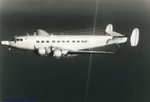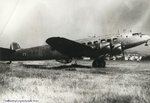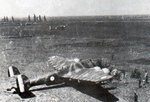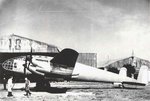- Thread starter
- #21
The first production LeO 451 was built in 1938. The decision to abandon Hispano-Suiza engines and a shortage of propellers resulted in production delays. The latter also caused most aircraft to be fitted with slower Ratier propellers which reduced the top speed from 500 to 480 km/h. As the result, although 749 LeO 451 had been ordered, only 22 were delivered by the start of World War II. Of these, only 10 were formally accepted by the Air Force. They were issued to a frontline unit tasked with experimenting the new type in the field, and flew a few reconnaissance flights over Germany, which resulted in the type's first combat loss.
At the start of the Battle of France on 10 May 1940, only 54 of the 222 LeO 451 that had been delivered were considered ready for combat, the remainder being used for training, spares, undergoing modifications and repairs or having been lost. The first combat sortie of the campaign was flown by 10 aircraft from GB I/12 and GB II/12 on 11 May. Flying at low altitude, the bombers suffered from heavy ground fire with one aircraft shot down and 8 heavily damaged. Within the next 8 days many of them were shot down, like the one piloted by sergent-chef Hervé Bougault near Floyon during a bombing mission over German troops. By the Armistice of 25 June 1940, LeO 451 of the Groupement 6 had flown approximately 400 combat missions, dropping 320 tons of bombs at the expense of 31 aircraft shot down by enemy fire, 40 written off due to damage, and 5 lost in accidents. A total of 452 aircraft had then been built, 373 accepted into service (including 13 for the Aéronautique navale), and around 130 lost in action in Europe.
Following the Armistice, LeO 451s continued to fly, now under the Vichy government. The aircraft were fitted with larger rudders and, later, two additional 7.5 mm machine guns in the rear turret. These extra weapons were added because of the limited capacity of the cannon magazines, and the fact that changing them in flight was extremely difficult. Aircraft production had totally stopped with the German occupation, but a 1941 agreement authorized Vichy authorities to have a limited number of military aircraft built. As a result, 109 additional LeOs were manufactured in 1942. The most notable of these was LeO 451-359 which was fitted with an experimental degaussing coil for remotely detonating naval mines (some British Vickers Wellingtons and German Junkers Ju 52s also carried a similar device). Two bomber units equipped with LeO 451s, GB I/12 and GB I/31 were based in Syria when Allied forces invaded on 8 June 1941, at the start of the Syria-Lebanon Campaign. These were supplemented by GB I/25, which was dispatched from Tunisia. During this campaign, the LeO 451s flew a total of 855 sorties, losing 29 LeO 451s in the process.
After Operation Torch which began on 8 November 1942, surviving French LeO 451 in North Africa were used primarily for freight duties, although they flew a few bombing missions against Axis forces during the Tunisia Campaign. They were ultimately replaced in active service by Handley-Page Halifax and B-26 Marauder bombers. Aircraft captured by Germans in occupied France were also used as transports after being specifically modified for this role. A small number was reportedly used by the Italian Regia Aeronautica. Following the war, the 67 surviving aircraft were mostly used as trainers and transports. The LeO 451 was finally retired in September 1957, making it the last pre-war French design to leave active duty.
At the start of the Battle of France on 10 May 1940, only 54 of the 222 LeO 451 that had been delivered were considered ready for combat, the remainder being used for training, spares, undergoing modifications and repairs or having been lost. The first combat sortie of the campaign was flown by 10 aircraft from GB I/12 and GB II/12 on 11 May. Flying at low altitude, the bombers suffered from heavy ground fire with one aircraft shot down and 8 heavily damaged. Within the next 8 days many of them were shot down, like the one piloted by sergent-chef Hervé Bougault near Floyon during a bombing mission over German troops. By the Armistice of 25 June 1940, LeO 451 of the Groupement 6 had flown approximately 400 combat missions, dropping 320 tons of bombs at the expense of 31 aircraft shot down by enemy fire, 40 written off due to damage, and 5 lost in accidents. A total of 452 aircraft had then been built, 373 accepted into service (including 13 for the Aéronautique navale), and around 130 lost in action in Europe.
Following the Armistice, LeO 451s continued to fly, now under the Vichy government. The aircraft were fitted with larger rudders and, later, two additional 7.5 mm machine guns in the rear turret. These extra weapons were added because of the limited capacity of the cannon magazines, and the fact that changing them in flight was extremely difficult. Aircraft production had totally stopped with the German occupation, but a 1941 agreement authorized Vichy authorities to have a limited number of military aircraft built. As a result, 109 additional LeOs were manufactured in 1942. The most notable of these was LeO 451-359 which was fitted with an experimental degaussing coil for remotely detonating naval mines (some British Vickers Wellingtons and German Junkers Ju 52s also carried a similar device). Two bomber units equipped with LeO 451s, GB I/12 and GB I/31 were based in Syria when Allied forces invaded on 8 June 1941, at the start of the Syria-Lebanon Campaign. These were supplemented by GB I/25, which was dispatched from Tunisia. During this campaign, the LeO 451s flew a total of 855 sorties, losing 29 LeO 451s in the process.
After Operation Torch which began on 8 November 1942, surviving French LeO 451 in North Africa were used primarily for freight duties, although they flew a few bombing missions against Axis forces during the Tunisia Campaign. They were ultimately replaced in active service by Handley-Page Halifax and B-26 Marauder bombers. Aircraft captured by Germans in occupied France were also used as transports after being specifically modified for this role. A small number was reportedly used by the Italian Regia Aeronautica. Following the war, the 67 surviving aircraft were mostly used as trainers and transports. The LeO 451 was finally retired in September 1957, making it the last pre-war French design to leave active duty.
Attachments
Last edited:



